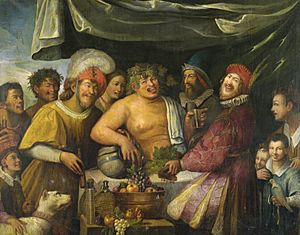The Triumph of Bacchus facts for kids
Quick facts for kids The Triumph of Bacchusor Los borrachos |
|
|---|---|
 |
|
| Artist | Diego Velázquez |
| Year | 1628-1629 |
| Medium | Oil on canvas |
| Dimensions | 165 cm × 225 cm (65 in × 89 in) |
| Location | Museo del Prado, Madrid |
The Triumph of Bacchus is a famous painting by Diego Velázquez. It is also known as Los borrachos (which means The Drinkers or The Drunks). You can see this painting today at the Museo del Prado in Madrid, Spain.
Velázquez painted The Triumph of Bacchus between 1628 and 1629. He created it for King Philip IV, who paid him 100 ducats for his work. Velázquez painted this piece shortly after moving to Madrid from Seville, and just before he traveled to Italy. In Madrid, he had the chance to study the king's large collection of Italian paintings. This helped him learn more about how artists showed mythological stories in their art.
Many people consider The Triumph of Bacchus to be one of Velázquez's best paintings from the 1620s.
What the Painting Shows
In this painting, Bacchus is at the center of a small party. His skin is much paler than the other people around him, which makes him easy to spot. What's interesting is that most of the other people in the painting are dressed like ordinary poor people from 17th-century Spain. Only Bacchus and the person behind him are wearing traditional robes, like those seen in ancient myths.
The painting shows Bacchus as a god who gives people wine. This wine helps them forget their problems for a while. In old stories and art, Bacchus was often seen as a symbol of freedom from the difficulties of everyday life.
You can think of the scene as having two parts. On the left side, Bacchus is brightly lit. He looks relaxed, almost like how Christ is sometimes shown in old paintings. Bacchus and the person behind him are dressed in the loose robes that artists used for characters from classical myths. The bright, clear light on Bacchus's face makes him look very ideal, like a perfect god.
The right side of the painting is different. It shows several men who look like they are having a good time. They seem to invite you to join their party. Their faces are not idealized; they look real and a bit worn, similar to the style of artist José de Ribera. The bright light on Bacchus is not on this side. These figures are shown with chiaroscuro, which means strong contrasts between light and dark, and their skin looks much darker.
Velázquez used a very realistic style for this mythological painting. He continued to paint mythological subjects in a similar way in the years that followed.
You can also see everyday objects in the painting, like the bottle and pitcher on the ground near Bacchus's feet. Velázquez used the bright light on Bacchus's body to make these objects stand out. They look almost like a still life painting within the larger work. These jars are very similar to ones Velázquez painted when he lived in Seville. Combining everyday objects with people in a scene was a style he often used in his bodegon paintings.
How This Painting Inspired Others
Many artists before Velázquez painted "The Triumph of Bacchus" in grand, idealized ways. For example, Titian's Bacchus and Ariadne was a very imaginative version. Usually, Bacchus was shown riding in a chariot pulled by leopards, with many satyrs and other party-goers. Velázquez's painting is quite different from these older versions.
Velázquez was likely inspired by other artists like Caravaggio and Ribera. Caravaggio often painted religious scenes with main figures in traditional robes and other people in modern clothes. Ribera painted realistic portraits of ancient figures, sometimes making them look like beggars.
Parties hosted by Bacchus were a common subject in art, often called a "Feast of the gods." For example, around 1550, Taddeo Zuccari painted a large feast for the Wedding of Bacchus and Ariadne. Some paintings, like the one by Frangipane shown earlier, also show Bacchus with people dressed in modern clothes.
Artist Mark Wallinger said that The Triumph of Bacchus was a bit like Velázquez's later famous painting, Las Meninas. He noted that the two figures on the left of Bacchus seem to look directly at the viewer. This makes us feel like we are part of the painting's story, even after hundreds of years.
See also
 In Spanish: El triunfo de Baco (Velázquez) para niños
In Spanish: El triunfo de Baco (Velázquez) para niños
- List of works by Diego Velázquez
- Feast of the Gods (art)


